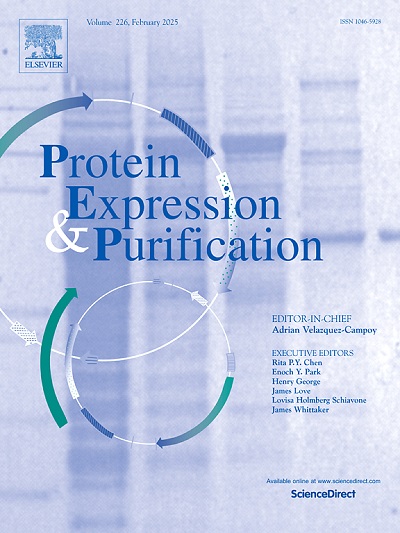人GalNAc转移酶T2和T11在大肠杆菌中的高可溶性表达及特性研究
IF 1.2
4区 生物学
Q4 BIOCHEMICAL RESEARCH METHODS
引用次数: 0
摘要
可溶性糖基转移酶在大肠杆菌中的高效表达仍然是一个重大挑战,经常导致错误折叠和包涵体的形成。在这项研究中,我们研究了提高人GalNAc-T2和GalNAc-T11的溶解度和催化活性的策略,这两种o -糖基转移酶参与糖蛋白的o -糖基化。我们发现,与麦芽糖结合蛋白(MBP)和纤维素酶催化结构域(Cel-CD)融合可以提高重组蛋白的溶解度,这使得大多数融合蛋白是可溶的。酶活性分析表明,融合糖基转移酶的催化效率明显高于非融合酶。此外,还测定了GalNAc-T11凝集素结构域对底物特异性的影响。凝集素结构域的存在对GalNAc-T11对特定底物的识别和比活性没有影响。这项工作为大规模生产具有增强生物活性的人糖基转移酶提供了一种有效的方法,突出了其在糖蛋白药物糖基化工程方面的潜力。本文章由计算机程序翻译,如有差异,请以英文原文为准。
High soluble expression and characterization of human GalNAc transferase T2 and T11 in Escherichia coli
The efficient expression of soluble glycosyltransferases from mammalian sources in Escherichia coli (E. coli) remains a significant challenge, often resulting in misfolding and the formation of inclusion bodies. In this study, we investigated strategies to enhance the solubility and catalytic activity of human GalNAc-T2 and GalNAc-T11, two O-glycosyltransferases involved in O-glycosylation of glycoproteins. We found that fusion with maltose-binding protein (MBP) and cellulase catalytic domain (Cel-CD), which led to majority of the fusion proteins being soluble, could increase the solubility of the recombinant proteins. Enzyme activity assays revealed that the fusion glycosyltransferase exhibited significantly higher catalytic efficiency than non-fused enzymes. In addition, the influence of GalNAc-T11 lectin domain on substrate specificity was also determined. The presence of lectin domain had no influence on the recognition of specific substrate and the specific activity of GalNAc-T11. This work offers an efficient approach for the large-scale production of human glycosyltransferases with enhanced bioactivity, highlighting its potential for glycosylation engineering of glycoprotein drugs.
求助全文
通过发布文献求助,成功后即可免费获取论文全文。
去求助
来源期刊

Protein expression and purification
生物-生化研究方法
CiteScore
3.70
自引率
6.20%
发文量
120
审稿时长
32 days
期刊介绍:
Protein Expression and Purification is an international journal providing a forum for the dissemination of new information on protein expression, extraction, purification, characterization, and/or applications using conventional biochemical and/or modern molecular biological approaches and methods, which are of broad interest to the field. The journal does not typically publish repetitive examples of protein expression and purification involving standard, well-established, methods. However, exceptions might include studies on important and/or difficult to express and/or purify proteins and/or studies that include extensive protein characterization, which provide new, previously unpublished information.
 求助内容:
求助内容: 应助结果提醒方式:
应助结果提醒方式:


